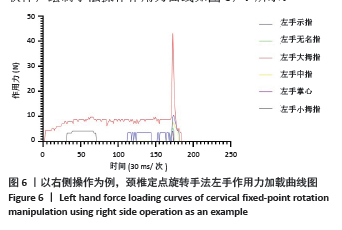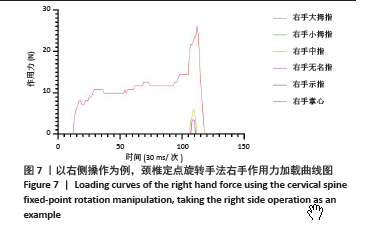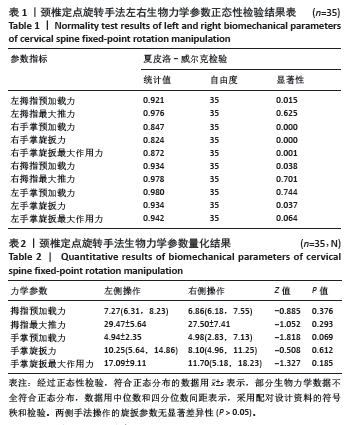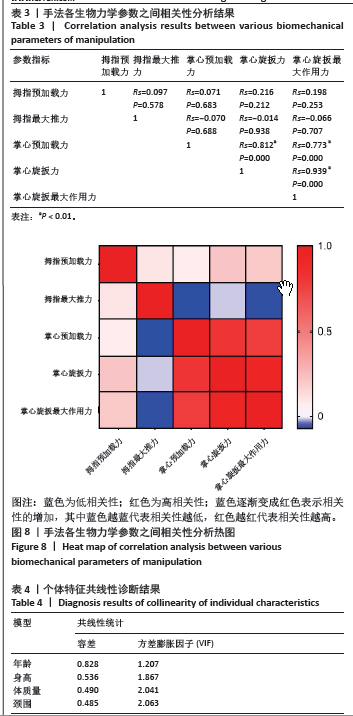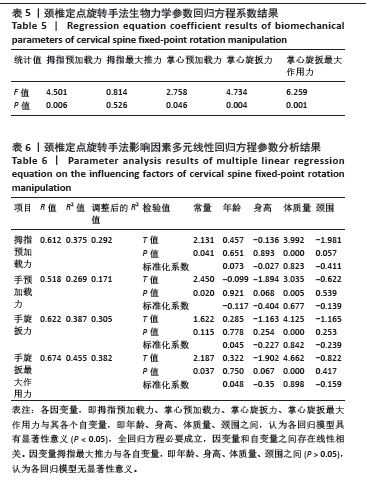中国组织工程研究 ›› 2025, Vol. 29 ›› Issue (3): 486-492.doi: 10.12307/2025.111
• 骨与关节生物力学Bone and joint biomechanics • 上一篇 下一篇
颈椎定点旋转手法在体生物力学量化及影响因素分析
梁基耀1,周红海2,3,4,韦贵康2,苏少亭1,陈龙豪2,5,何心愉1,刘粮酺1
- 1广西中医药大学研究生院,广西壮族自治区南宁市 530001;2广西中医药大学骨伤学院,广西壮族自治区南宁市 530001;3广西中医骨伤科生物力学与损伤修复重点实验室,广西壮族自治区南宁市 530001;4国医大师韦贵康学术思想与临床诊疗传承发展研究中心,广西壮族自治区南宁市 530001;5浙江中医药大学附属第三临床医学院,浙江省杭州市 310000
Quantification of in vivo biomechanics and analysis of influencing factors in cervical spine fixed-point rotation manipulation
Liang Jiyao1, Zhou Honghai2, 3, 4, Wei Guikang2, Su Shaoting1, Chen Longhao2, 5, He Xinyu1, Liu Liangpu1
- 1Graduate School of Guangxi University of Chinese Medicine, Nanning 530001, Guangxi Zhuang Autonomous Region, China; 2Orthopedic College, Guangxi University of Chinese Medicine, Nanning 530001, Guangxi Zhuang Autonomous Region, China; 3Guangxi Key Laboratory of Biomechanics and Injury Repair in Traditional Chinese Medicine Orthopedics and Traumatology, Nanning 530001, Guangxi Zhuang Autonomous Region, China; 4Research Center for the Inheritance and Development of Academic Thought and Clinical Diagnosis and Treatment of Wei Guikang Master of Traditional Chinese Medicine, Nanning 530001, Guangxi Zhuang Autonomous Region, China; 5Third Clinical Medical College Affiliated to Zhejiang Chinese Medical University, Hangzhou 310000, Zhejiang Province, China
摘要: 
文题释义:
颈椎定点旋转手法:是治疗颈椎病及颈椎小关节紊乱等颈椎疾病常用的一种手法,由于其操作安全简便,疗效肯定,广泛应用于临床。生物力学:基本思想是运用数学与物理力学相结合的方法,对人体在各个活动过程中所产生的各种力学问题进行分析。
摘要
背景:颈椎定点旋转手法属于技术要求较高的力学操作,但目前其生物力学还缺少相关量化数据;且颈椎定点旋转手法的影响因素研究包括了众多参数并且存在差异性,需要进一步对其影响因素进行分析,以完善其相关数据。
目的:量化颈椎定点旋转手法在体生物力学参数,探讨各生物力学参数之间的相关性,及研究对象个体特征差异对手法力学参数的影响。
方法:选取35例颈椎病患者为测试对象,均为广西中医药大学第一附属医院仁爱分院骨伤科门诊就诊者。术者佩戴穿戴式力学测量手套采集手法力学参数,包括拇指预加载力、拇指最大推力、掌心预加载力、掌心旋扳力和掌心旋扳最大作用力。并采集患者个人特征参数,包括年龄、身高、体质量和颈围。对手法操作过程中的关键力学参数进行特征分析及不同个体特征进行量化,对力学指标参数进行Spearman相关性分析;分析不同个体特征参数对生物力学可能存在的影响。
结果与结论:①双侧力学参数相比,左侧操作与右侧操作无显著差异性(P > 0.05)。②拇指预加载力均值为(7.21±1.19) N、拇指最大推力均值为(28.40±4.48) N、掌心预加载力均值为(5.67±2.49) N、掌心旋扳力均值为(10.90±5.11) N、掌心旋扳最大作用力均值为(16.00±7.27) N。③掌心预加载力和掌心旋扳力存在显著正相关(Rs=0.812,P < 0.01);掌心预加载力和掌心旋扳最大作用力存在显著正相关(Rs=0.773,P < 0.01);掌心旋扳力和掌心旋扳最大作用力存在显著正相关(Rs=0.939,P < 0.01)。④患者体质量与拇指预加载力、掌心预加载力、掌心旋扳力及掌心旋扳最大作用力之间存在显著正相关(P < 0.05)。⑤结果证实,颈椎定点旋转手法治疗颈椎病操作中生物力学有一定的标准量值。该手法左右侧操作无显著差异性,具有较好的一致性和可重复性。掌心预加载力、掌心旋扳力及掌心旋扳最大作用力3种力之间存在一致性和协调性,对于治疗效果的贡献是相近的。患者的体质量是影响颈椎定点旋转手法重要的因素。
https://orcid.org/0009-0002-4328-9687(梁基耀);https://orcid.org/0000-0002-2382-5916(周红海)
中图分类号:
